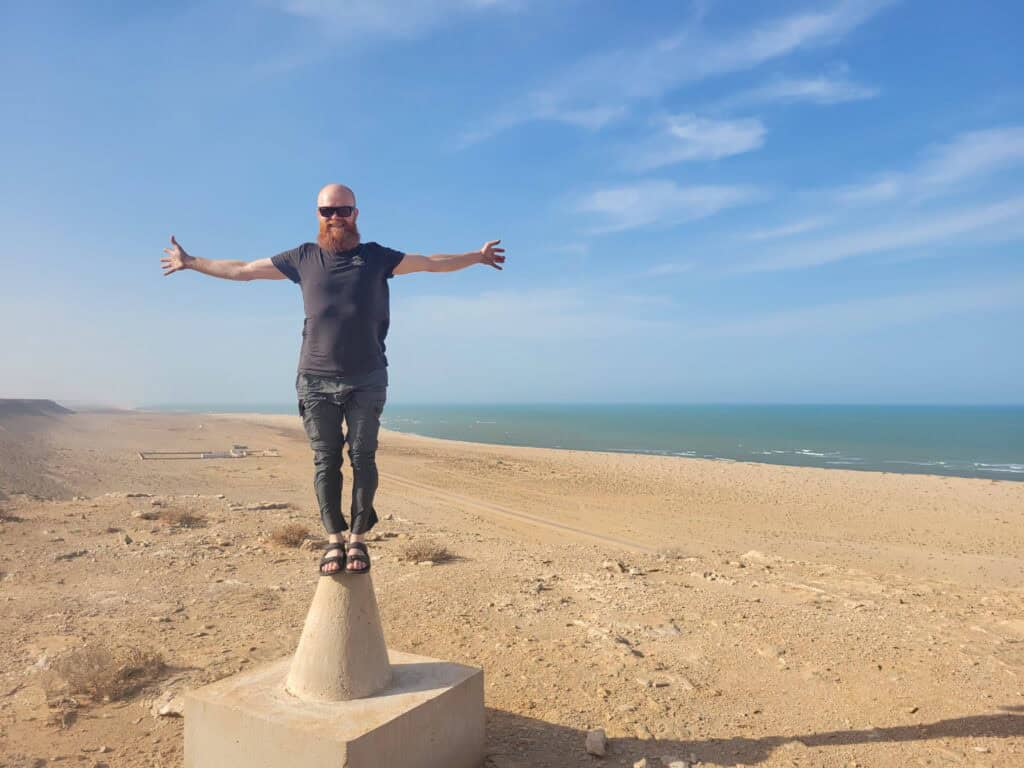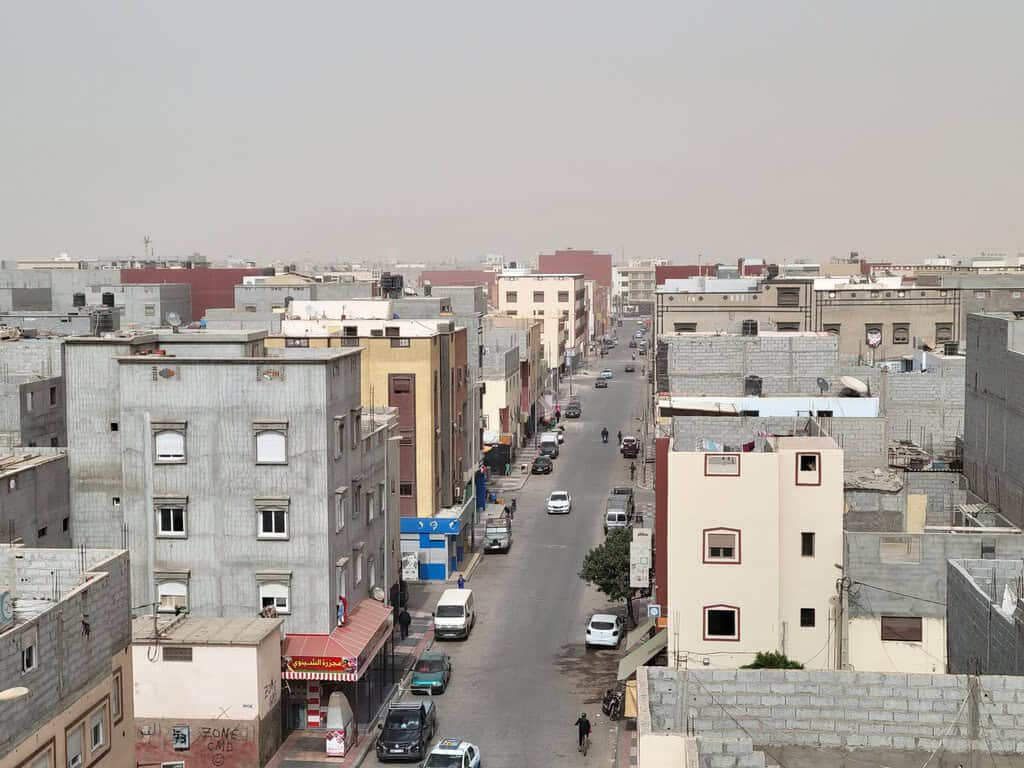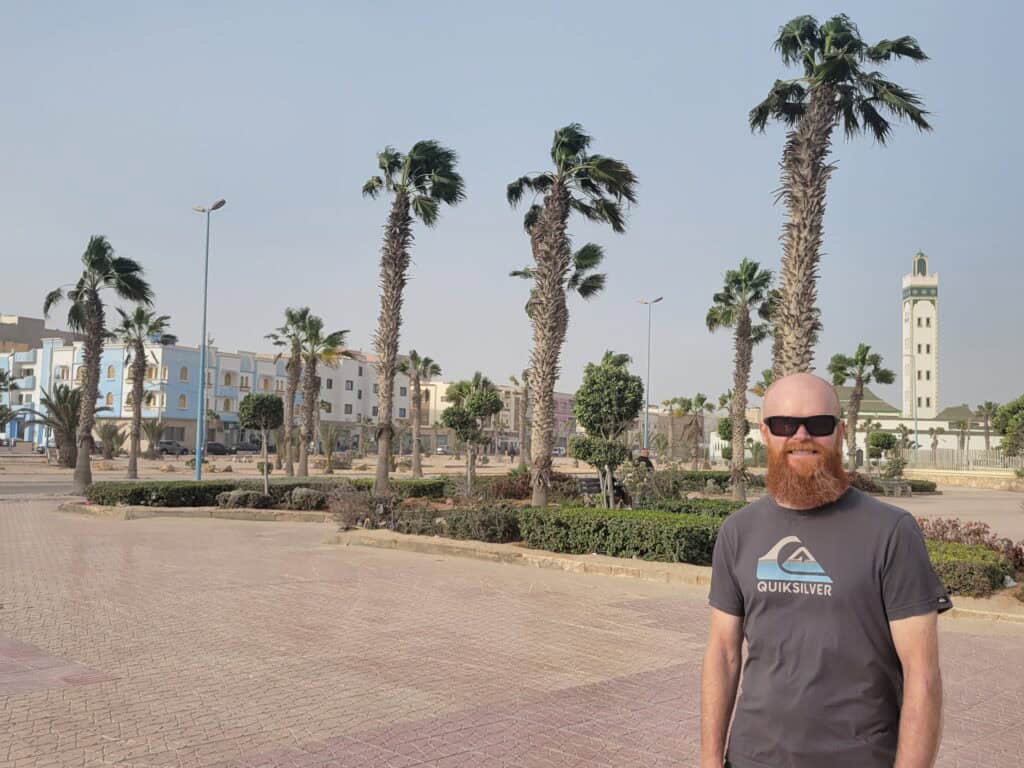Want to know if it’s possible to travel in Western Sahara? Or what resources you will find? Western Sahara – Useful Information for Travellers is our personal experience exploring this country in 2024. Our adventure includes Laayoune and Dakhla. We share our insights on where to stay, where to eat and drink, and things to see and do. Western Sahara – Useful Information for Travellers reflects our travel style and aims to provide useful things to know before visiting this obscure destination.
Western Sahara is a disputed territory in Southern Morocco. Known as ‘Spanish Sahara‘ until 1976, the area is rich in phosphates, but short on water, the main water source being a desalination plant built in 2022. Western Sahara stretches from Tarfaya in the North, to Mauritania in the South. Tar is a small village on the unofficial border between Morocco and Western Sahara. Interestingly, Western Sahara has the world’s second largest wall made from sand, 2700km long. It is sparsely populated and has plenty of desert. Most people pass through here on their overland trips heading South. It’s not easy to reach, but getting here is rewarding.
We drove here while taking part in The Dakar Challenge.
Why go to Western Sahara?
Western Sahara is a unique and very isolated place with dramatic landscapes and harsh living conditions. It is a memorable experience because it is so different. Beautiful sands and skies can be changed instantly by desert wind storms, and vibrant friendly streets can suddenly become dusty and uncomfortable. The people who live here are resilient and go about their day in their usual way, they smile and talk, and bring the grey dusty streets to life. Locals are curious and say hello. They are helpful and seem to want you to feel safe and welcome. The resources are basic but people work hard to offer consistent quality in their products and services. Western Sahara has its own identity. It’s not Morocco or Mauritania. Its unique and different.
- Capital: Laayoune
- Best time to visit: December – March
- Budget/Mid-Range/Couple: AU$80 per day
- Currency: Dirham (MAD6 = AU$1)
- Language: Arabic, Spanish, French
- Visa: No
- Difficulty: 2 (1-basic & 5-challenging)

Laayoune
Laayoune means ‘water source’ in Arabic. This was no doubt the case at some stage. Laayoune ‘city of sand dunes’ is much more accurate now. Laayoune is a city with grand plans, as you will notice when reaching the city outskirts, with a grand archway under construction. This is followed by a long tidy palm lined street and finally a bridge which offers your first view of the city. Newer parts of the city, around the edges, have large apricot buildings. The city centre is old, with the usual traffic, smells, sand and dust. The central fountain with a grand McDonalds next to it shows that progress is coming, and nowhere is outside its long reach. There are mini markets and cafes, fast food and bakery’s, even a fresh sushi shop. It’s hard to see fresh produce or restaurants at first glance. Signs and menus are in Arabic. But ask where or what something is and people will be happy to help.
Getting to Laayoune
We drove from Sidi Ifni to Laayoune. The journey took seven hours with a few stops. The roads are in good condition. Wind turbines fill the horizon. Sand and more sand make it seem harsh and unwelcoming, but you will see people, tents, camels, herders and houses randomly during the drive, proof that it is not only hospitable, it’s also a home.
You can fly to Laayoune, but that would be missing the main attraction, the beautiful Sahara and the surprising life that it supports.
There’s plenty of new roads under construction. It’s unlikely these are for the expected tourism boom, more likely for the trucks to carry resources out of the area. Either way, it’s only going to be quicker and easier to get to Laayoune. Bring plenty of fuel and supplies. There’s a few small towns along the way, with limited resources.
Where to stay in Laayoune
We chose to stay in an Airbnb in the centre of town. It had a good range of new appliances (blender, oven, stovetop, TV) and a comfy bed. The host spoke English, and we were able to ask questions and get local recommendations. Whatever you manage to find, your host will be excited to see you and do whatever they can to make your stay pleasurable.
There’s basic hotels and some guesthouses around, but the nicer ones are usually booked by the UN staff or other officials who are in town.
Where to eat and drink in Laayoune
There are many cafes, mini markets and small shops with a variety of very basic staples. On our first walk around town, we found a small shop selling a few fruits and vegetables. There’s plenty of fresh bread around and we found a small bread shop with three lovely women who answered all of our questions about their freshly made cakes and breads. Laayoune offers fast food options if that’s your scene, including McDonalds, pizza and a food truck in the park.
The best vegetable and fruit market is at the top of town, and well worth the short trip to reach it. If you are self-catering, this place is a must visit. There’s a surprising variety of quality produce, and the stall holders are only too willing to chat. We enjoy self-catering with local fresh produce and enjoyed our daily catch ups with the friendly vendors here.
- Don’t miss Marche aux legumes et fruit en gros (friendly local fruit and vegetable market)
- Get to Dar Elbaldi (small local eatery, nice lentil soup and fresh bread)
- Check out Sushikom Sud (watch him make your sushi fresh as he shares his success story with you)
Things to see and do in Laayoune
Grand Mosque A nice walk through the streets to reach it.
Protection of Prehistoric Industries Association This is a small museum run privately by a local guy. He’s collected hundreds of artifacts from his journeys through the desert. Opening times vary.
Wander the City The city itself is an attraction. The fact that it thrives in the surrounding environment is a wonder. Watching the people go about their daily lives is interesting and was such a highlight of our time here. Men drinking coffee in cafes, woman running errands dressed in colourful fabrics wrapped neatly around their body, traffic police at roundabouts, and rubbish collectors cleaning the streets. A great way to find small shops, patisseries and restaurants too.
Getting around Laayoune
The town is easy enough to drive around if you have a car. Taxis are the main form of public transport. The main city centre is easy enough to navigate on foot.

Dakhla
A kite and windsurfers paradise, Dakhla is obviously a very windy destination. There’s loads of resorts on the outskirts of town. The city has vast areas of vacant land, ready for development. There’s amazing scenery, and it’s hot. Dakhla sees very little rain, so it’s dusty. The city is on a windy waterfront, so the central streets a few blocks back offer some protection from the wind and dust. People go about their business in the wind, dust, sand or sun with an uplifting energy. The weather here was some of the harshest we experienced, but it was just another day in the lives of the locals who went about their usual routines. Shops and restaurants line the streets, and street vendors push their carts to their daily spot. Mornings are slow, with fresh bread and tea luring a quiet crowd. Evenings are cool and late meals popular.
Getting to Dakhla
We drove from Laayoune to Dakhla. The drive took 6.5hours. The road is in good condition, and there’s non-stop scenery – coastline, shipwrecks, homes and tents. There’s numerous checkpoints along the way. Follow the instructions from the officers and you won’t have any problems.
You can also fly to Dakhla from Paris and various Moroccan cities. From Dakhla to the Mauritanian border is a 4.5hour drive.
If you are heading to Mauritania, Hotel Barbas is the last stop before the border. It’s MAD350 per night double room. There’s a restaurant, small shop, ATM and petrol station. The staff are friendly and speak English. They made us feel very welcome and even made us a vegetable tajine.
Where to stay in Dakhla
If resorts are your preferred option, then you won’t have a problem finding somewhere on the outskirts of the city, on the water. If you prefer to stay in the city, there’s various hotels and guesthouses. It gets busy here, as it’s a popular trip away for Moroccans. We stayed in a Airbnb a few streets back from the water. This area was protected from the worst of the wind and had good resources all within walking distance. Apartments are very basic and only just comfortable. However, the hosts will go to great efforts if you need anything, including utensils in the kitchen. We had a huge tajine so made our first vegetable tajine. A cold shower and respite from the dust will quickly become all you need here.
Staying anywhere around the centre of the city would allow you to walk to most of the sights.
Where to eat and drink in Dakhla
Plenty of local eateries around the city, and while not everything is easy to find at first, the locals can tell you where to find things. We found locals to be polite, friendly and happy to help (and you really do need their help). Fish and beef are popular. Locals helped us to find a vegetable tajine by directing us to someone who was happy to cook that for us. The resources in the centre of town included a spice shop with fresh dates and olives, small grocery stores, fresh fruit and vegetables, a nut stand with freshly roasted nuts, and a local coffee shop. There was a couple making fresh flat breads every morning, with fillings and tea. There is a larger grocery store down near the waterfront, but variety is still limited.
- Get to the small restaurant across from Dakhla Smile Dental (its joined to a butcher, but he will prepare delicious vegetable tajines with a couple of hours notice)
- Don’t miss Chez Ntifi (Lovely home cooked meals and vegetarian options if you give them notice)
Things to see and do in Dakhla
The main attraction here is the water Wind surfing, kite surfing and the beach are popular pass times. Moroccans flock here for the sun and sand. On a calm day it is beautiful, and we loved watching all the action out on the ocean. Quad biking and adventure activities are abundant.
Immerse yourself Stay amongst the locals and immerse yourself in the daily life of the people. It is an experience that you won’t forget.
Getting around Dakhla
It’s a windy city, so a car or taxi is the preferred way to get around town. If there is no wind, you can walk.

Getting to Western Sahara
The drive from Sidi Ifni to Laayoune takes seven hours, or Dakhla (six hours)
You can fly from Casablanca, Agadir, or Dakhla. It’s a very remote destination, with limited access, so plan well. Plenty of European holiday makers make the journey from Spain down to Dakhla in their campervans. The roads are in good condition, and there is a fair bit of road works going on to improve them even more. There’s small towns or villages along the way where you can fill up with fuel, and grab a water, but don’t count on finding anything but the most basic supplies. Fuel sometimes runs out along this route, so take the opportunity to fill up whenever you can. It’s a scenic drive. Watch out for camels and sand drifts on the road.
Useful things to know before visiting Western Sahara
Western Sahara is a disputed territory. It is classified as a non self-governing territory. The UN does not recognise it as an independent country, nor does it recognise Moroccan control. It is an ongoing conflict with the UN searching for a peaceful solution. It is often referred to as ‘Sahara’.
There is a lot of police checkpoints. These are generally problem free and the officers are friendly and want to have a chat. Have your documents, such as car insurance and license ready. It’s a good idea to prepare some forms with these details all set out clearly on it, so when you come to a checkpoint, all you have to do is hand over your prepared form. We used about fifty during our trip.
Things can be basic or hard to find – ask locals – we found people to be friendly and happy to help, they want you to feel welcome and comfortable.
Vegetable dishes may not be on the menu, but just ask or look around – we found vegetable tajines in seafood restaurants and had a butcher offer to cook us a vegetable tajine!
Learn a couple of phrases, “Choukran” means “Thankyou” in Arabic.
You won’t find too much in the way of luxury, but what you will find is people trying their best to make you feel comfortable.
Final thoughts on travelling in Western Sahara
Western Sahara is like no other place we have been, which is an attraction in itself. In all honesty, its cities offer little for the visitor in the way of sights, and there’s lots of driving, but what entices you to Western Sahara is that it’s truly different. The scenery is spectacular, and the variety of people who call Western Sahara home are genuinely just as curious of you as you are of them. They welcome you with a smile or a chuckle, as you are just as unique to them. Is it a place I’d return to again and again? Probably not. Is it a place I’ll always remember? Absolutely! Am I glad I came? 100%. Western Sahara is truly an obscure destination.
